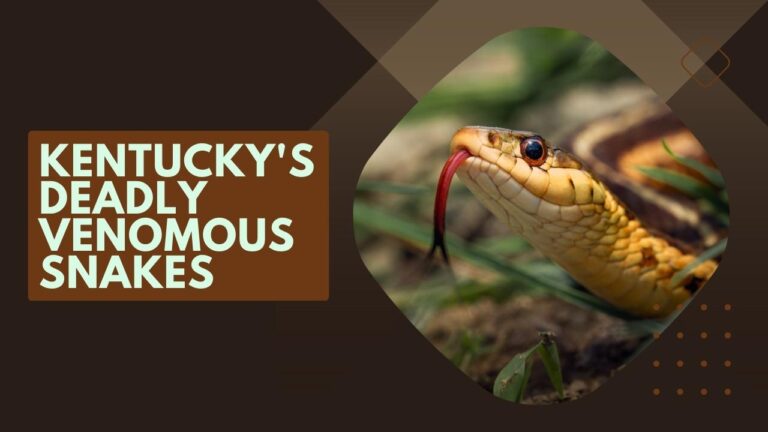Kentucky is home to four venomous snake species: the copperhead, cottonmouth, timber rattlesnake, and pygmy rattlesnake. While they play an important role in the ecosystem, encounters with them can be dangerous if proper precautions are not taken.
Knowing how to identify them is essential for anyone who spends time outdoors in Kentucky. In this article, we will provide an overview of each of these venomous snake species, including their appearance, habitat, behavior, and venom characteristics, to help you stay safe in snake country.
1. Copperhead
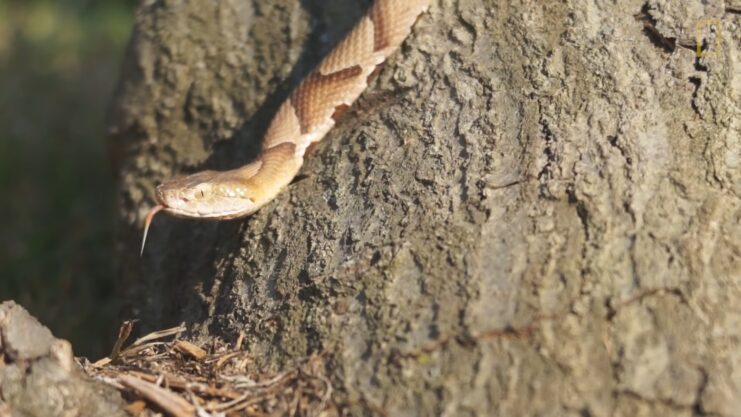
They are one of the four venomous species of snakes found in Kentucky. Copperheads can be identified by their coloring, which ranges from light tan to reddish-brown and is covered with crossbands that may be darker in the middle or hourglass-shaped.
They can also be identified by the shape of their head, which is triangular and flat. Additionally, copperheads have vertical pupils and smooth dorsal scales.
Description
The copperhead is a species of venomous snake located in Kentucky. It is a medium-sized snake, typically ranging between 24-36 inches long. It has a reddish-brown or brownish-gray body with darker hourglass-shaped crossbands down its back and tail and has yellowish-brown eyes.
On its belly, it has bands that are either solid or broken but all have some pattern of bands or spots in the same alternating dark/light coloration. The copperhead’s head is light-colored with a dark line that runs through it. It may also have two facial pits located between their eyes and nostrils which they use to detect its environment.
The copperhead is an ambush predator that feeds on small rodents, frogs, insects and slugs, though young copperheads will inject venom into their prey before consuming them whole.
Copperheads are one of the least dangerous species of snakes found in Kentucky as their bite does not normally cause any serious side effect aside from some localized swelling, tenderness and pain for up to several hours after being bitten; however medical attention should be sought if necessary, especially for young children or those more prone to allergic reactions.
Habitat
The copperhead is the most common and widespread venomous snake species in Kentucky. This species is a habitat generalist that can inhabit lowland bottomlands and dry ridges. Generally, they are found in forests, fields, marshes, and rocky bluffs and can sometimes be found along streams. They usually don’t venture very far from cover and can commonly be found underneath logs, rocks or leaf litter.
Copperheads are active during the late evening hours when they are searching for prey such as insects, lizards, frogs and small rodents. In the state of Kentucky, copperhead sightings may occur year-round due to the mild climate; however, their activity level may be reduced during colder months due to their sensitivity to cold temperatures.
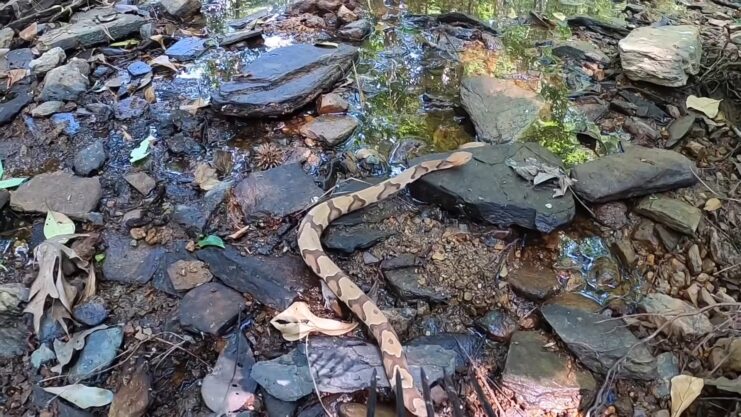
Range
Copperheads are the most common venomous snakes in Kentucky and are primarily found in the eastern half of the state. There is an isolated population near Big South Fork park in east central Kentucky. Generally, they inhabit woodlands and rocky areas such as stream beds, creeks, and woodpiles.
Copperheads have a characteristic broad, triangular-shaped head which helps distinguish them from other nonvenomous snakes so it is important to look for this feature along with the characteristics below when identifying them. They have a yellowish-brown body with hourglass-shaped crossbands that can vary from yellowish, and reddish to coppery in color.
Copperheads feed on small rodents, frogs, insects and other small reptiles. The adults usually reach two feet in length but can attain a maximum size of three feet or more.
2. Cottonmouth
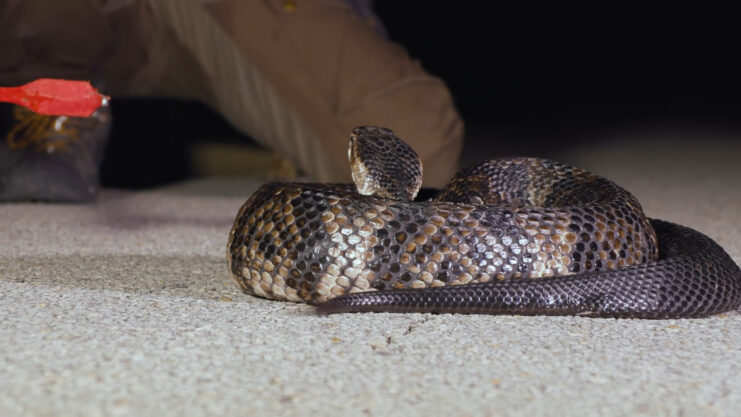
The cottonmouth, also known as the water moccasin, is one of the four venomous snakes found in Kentucky. It is a large, heavy-bodied snake typically ranging in length from two to four feet. It can be identified by its distinct coloration and markings.
The body is typically brown, yellow, or black and is covered in dark, cross-shaped bands. The underside is yellow or white and may contain dark spots. The cottonmouth also has a triangular-shaped head, wide jaw, and black mouth and can often be found near streams and in wetland habitats.
Description
The cottonmouth, also known as the water moccasin, is a venomous snake native to the southern United States. It is one of four types of venomous snakes found in Kentucky. The scientific name for this species is Agkistrodon piscivorus and it belongs to the pit viper family Crotalidae.
This species is an ambush predator and can be found living near water sources such as creeks, rivers or ponds in areas with soft mud and plenty of grassy or bushy cover.
Cottonmouths can typically grow up to 3 feet in length and their color ranges from a dark bronze or brownish-black to a yellow or greenish color with dark patches that form a wide cross-band pattern over their back.
Cottonmouths typically have a pit of heat-sensitive receptors between the eye and nostril which help them detect potential prey at night or in murky waters. They are capable of inflicting severe pain if they bite, so it’s important to know how to identify this species if you are found in areas where cottonmouths live.
Habitat
The Cottonmouth (Agkistrodon piscivorus) is found in Kentucky and is a member of the viper family. Kentucky is a home to many wild animals including big cats! You should always stay alert when exploring the wild.
It is also referred to as the Water Moccasin, probably because it often lurks among vegetation near water sources such as ponds, lakes, rivers, swamps and other wetlands.
They also can be found in regions with plentiful rainfall and humidity, such as lowland forests or floodplains. However, they have been known to inhabit dry uplands healthy populations of Cottonmouths can normally be found in tree-broken areas where they remain well camouflaged among rocks and logs.
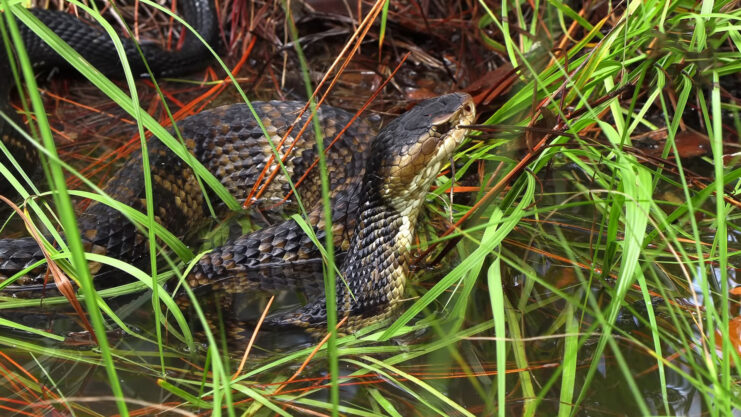
Range
The range of the Cottonmouth (also known as the Water Moccasin), found in Kentucky, is not limited to Kentucky alone. Cottonmouths can be found in nearly all freshwater habitats throughout the eastern United States and north into southern Ontario and Quebec, Canada. They inhabit rivers, lakes, ponds, sloughs, marshes and swamps.
Cottonmouths may wander far from water sources in search of food or shelter, typically traveling less than a mile from the water. In some areas, they can occasionally be found at higher elevations within their range, but these will likely be watershed drainages or tributaries leading to them. They are excellent swimmers that are capable of traversing both still and moving waters.
These large semi-aquatic pit vipers may also share a habitat with other large aquatic snakes like Diamondback Watersnakes (Nerodia rhombifer) and Yellow Bellied Water Snakes (Storeria flavigaster). Juveniles may occasionally feed on small fish with larger adults more likely to take large frogs or mammals such as muskrats or voles.
3. Timber Rattlesnake
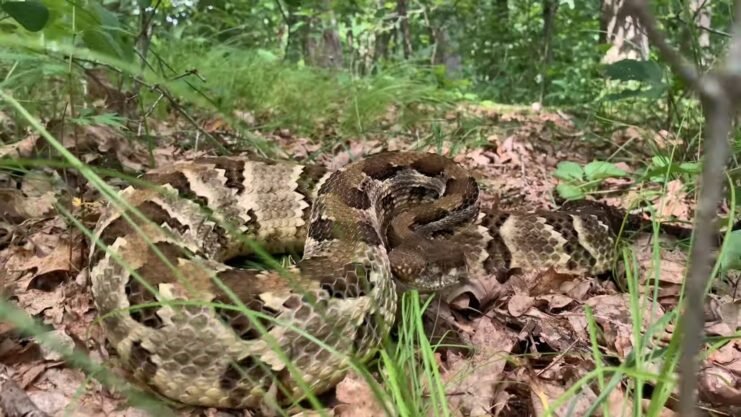
The Timber Rattlesnake, also known as the Eastern Timber Rattlesnake, is one of the four venomous snakes found in the state of Kentucky. It is typically a dark brown or black in color, with diamond-shaped crossbands and a spotted belly. It has a rattle on the end of its tail that produces a distinctive buzzing sound.
This snake can grow to be up to five feet long, and is known to be aggressive if disturbed.
Description
The timber rattlesnake (Crotalus horridus), also known as canebrake rattlesnake or banded rattlesnake, is a species of venomous pit viper found in the eastern United States. It usually has black or brown blotches and rings along its body, with a distinct pattern of light yellow spots and marks on its face.
Timber rattlers have distinctive diamond-shaped heads with elliptical eyes and vertically slit pupils. They can grow up to 4 feet in length, but are typically between 2 and 3 feet long.
They have rattle structures made from stacks of interlocking keratin scales that they shake loudly to warn potential predators. When threatened or startled, these snakes may raise their bodies in large arcs and coil loosely into S-shapes. Their venom is considered medically important because it allows them to hunt larger prey like rodents and other small mammals.
Habitat
The timber rattlesnake (Crotalus horridus) is the most widely distributed venomous snake in Kentucky, inhabiting various regions of the state. They prefer deciduous forests and are highly elusive. They spend much of their lives hidden, making negative human contact unlikely.
They can be found living in old fields and rocky lumberland, but they typically prefer the woodland at the forest edge because they can hunker down among rotting logs or seek out sunlight while staying sheltered by shrubs and trees.
The natural habitation areas these snakes inhabit are sometimes referred to as red cedar ridge communities. In addition to providing hiding spots for timber rattlers, this type of environment also shelters a variety of other wildlife that can serve as food for them.
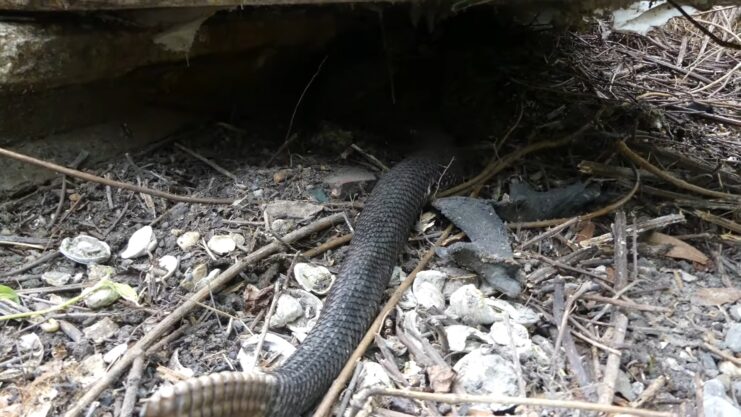
Range
Also known as Crotalus horridus, it is found in the eastern half of the United States from New York to Nebraska, south to central Florida and Texas. In Kentucky, it can be found primarily in the Appalachians between the Tennessee and Louisiana state borders.
The habitat for this species includes deciduous forests and rocky hillsides. They have even been seen occurring at higher elevations on cliffs and in caves. This species tends to inhabit areas close to water such as creeks, lakes, and rivers, where they can often be seen basking on rocks or immersed in shallow water with their heads sticking above the surface.
Adult ones will migrate seasonally between hibernacula during autumn and warmer climates during summer due to their thermoregulation needs.
4. Pigmy Rattlesnake
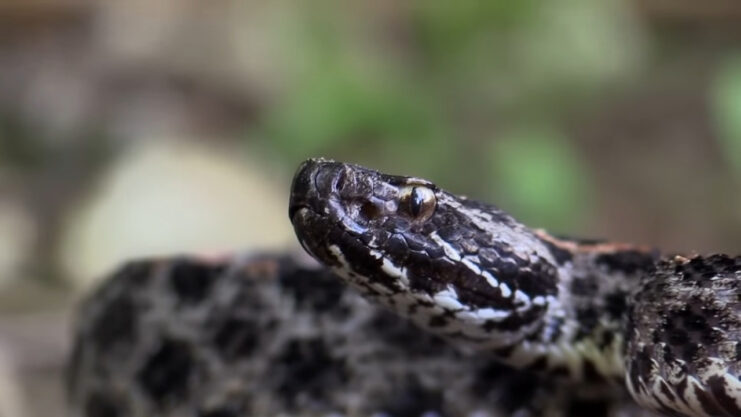
Out of the four species of venomous snakes found in Kentucky, the pigmy rattlesnake is one of the smallest species. It is usually found in dry, rocky locations, and areas of deciduous forests. It has a distinct rattle on its tail, which is used to warn predators when they feel threatened.
In this section, we’ll take a look at how to identify this venomous snake.
Description
Also known as the ground rattlesnake, is a small species found throughout Kentucky. It is typically grayish-brown in color with darker arrowhead-shaped bands running down its body and a slender tail that ends in a small rattle.
The adults can reach lengths of up to 15 inches and typically weigh 4 ounces or less. Juveniles are much smaller and may lack the arrows found on adults. It has large eyes for hunting at night and thick scales to protect it from predators.
Like other venomous snakes, it has movable fangs located at the front of its mouth that allow it to inject venom into prey or attackers. Its venom is not usually strong enough to be dangerous to humans but can still cause considerable pain if bitten.
They typically shy away from humans and will only strike when threatened or startled, so it’s important to give them plenty of space if you spot one in your area!
Habitat
Also known as the ground rattler, is found in a variety of habitats in Kentucky. They prefer forests and can be seen crossing open fields or sunning themselves on logs. During colder months, they may hibernate underground in abandoned mammal burrows near bodies of water. They are generally not found above 4,500 feet in elevation or away from sources of water.
This species of rattlesnake is not an active climber and primarily lives on the ground although they may climb occasionally to reach a higher basking area such as a log or rock pile.
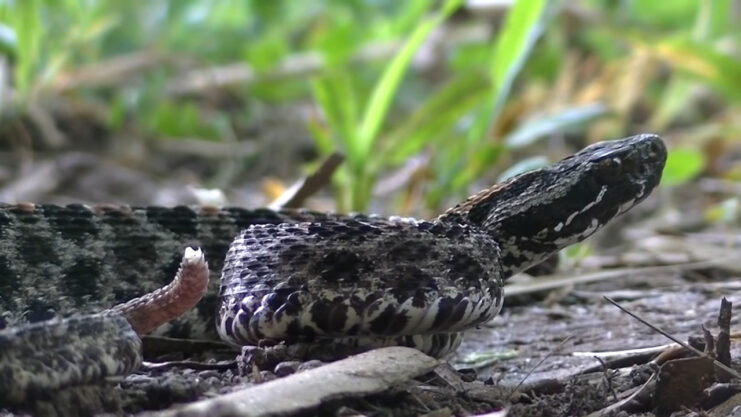
Range
They are the smallest of the four venomous snakes living in Kentucky. These small, but dangerous snakes have adapted to live in a range that stretches from southeastern Missouri, up through Illinois and into parts of Kentucky, Indiana and Ohio.
They prefer dry habitats with plenty of covers such as thickets of cedars or rocky hillsides. However, they have been known to take up residence around the edges of rivers or streams.
The males typically grow to 18-22 inches in length while females may exceed 24 inches. They have brown and grayish bodies with beige and cream spots along the backside and sides. As in other rattlesnakes, these spots become more brilliant on a pigmy’s head and snout during the breeding season (Spring/Summer).
Their tails bear two dark stripes that meet at a triangle-shaped rattle at their end. During hot summer nights, you’ll likely hear their rattle when it vibrates across their body scales — making them easy to spot if you’re out walking after dark!
Identification Tips
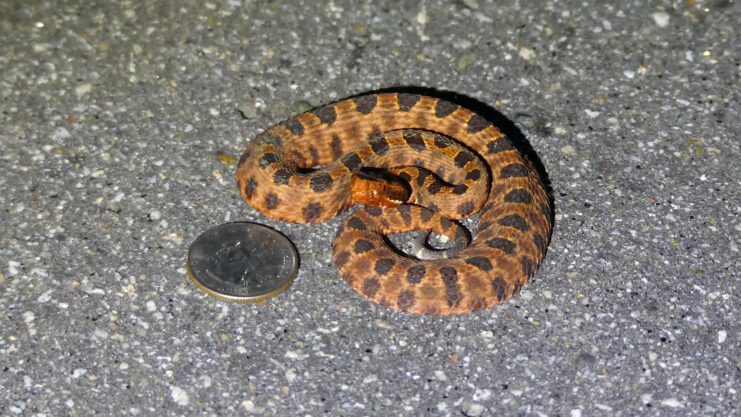
Identifying them can be a challenge, but it is important to keep yourself and your family safe from these dangerous creatures. Knowing how to identify the four types of venomous snakes found in Kentucky – copperhead, cottonmouth, timber rattlesnake and pigmy rattlesnake – is key.
Size
Although their size can vary between seasons, due to factors such as current food availability, overall size and body shape can help in the identification of venomous snakes.
The four species of venomous snakes native to Kentucky range in length from 16-54 inches (41-137 cm). The copperhead is the smallest of the four and averages 16-30 inches (41-76 cm); followed by the cottonmouth which is usually 18-36 inches (45-91 cm); then the timber rattlesnake which averages 36-48 inches (91-122 cm); Lastly, the pigmy rattlesnake can be up to 54 inches long (137 cm).
It is important to remember that although body size gives a good indication, it is not always consistent between individuals and between regions. As with any type of snake identification, be sure to consider all other key characteristics for complete accuracy.
Behavior
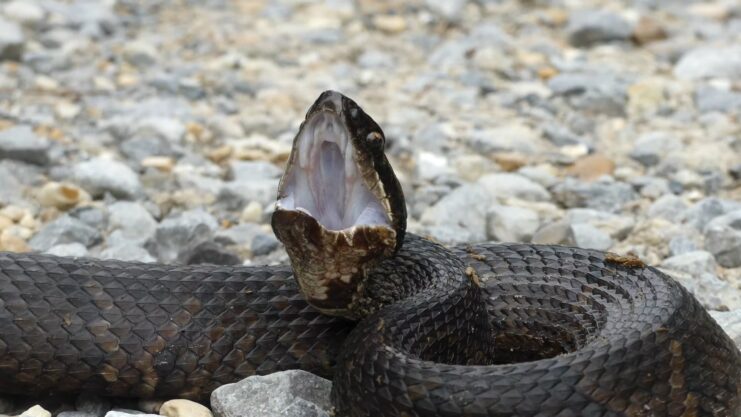
Identifying the four venomous snakes native to Kentucky can be a challenging task. Although each snake type may look slightly different, they all generally have similar patterns and characteristics. However, observing behavior is often the best way to distinguish particular species apart since they can be difficult to tell apart based solely on appearance.
1. Copperhead
They tend to shy away from contact and will often freeze in place as a form of camouflage when encountering potential threats. They would rather retreat than fight and will usually not defend themselves unless provoked or threatened.
2. Cottonmouth
The most aggressive among venomous snakes in Kentucky, cottonmouths are semi-aquatic and often stay near bodies of water such as rivers, streams or swamps. They may use their mouth as a defensive threat display when alarmed or feel threatened – opening their mouth wide to show their white-colored inside that gives them their name ‘cottonmouth’.
3. Timber rattlesnake
These are rarely seen out in the open and like to take shelter under rocks or debris for camouflage and security. When agitated, timber rattlesnakes may coil up defensively and rattle its tail at its intruder – hence ‘rattlesnake’ in their name – while lunging with an open-mouthed strike resembling a cobra’s hood.
4. Pigmy rattlesnake
Unlike other pit vipers which blend into their environments, this species have bright diamond patterns on a light background with yellow tipped tails meant for warning predators away before having to rely on defense mechanisms such as striking with venomous fangs — an adaptation known as ‘apologetic coloring’ meant to increase chances of survival without entering into dangerous physical confrontations with predators who don’t recognize them immediately.
Safety Tips
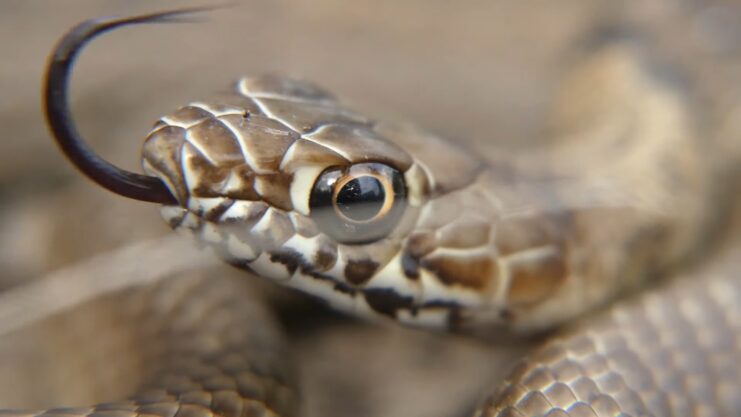
When it comes to snake safety, it is important to know how to identify the four venomous snakes in Kentucky: copperhead, cottonmouth, timber rattlesnake, and pigmy rattlesnake. Being able to recognize and properly respond to these venomous snakes can be the difference between life and death.
Kentucky is home to a wide variety of wildlife, including some potentially dangerous animals.
Avoiding snakes
Avoiding them altogether is a smart idea to stay safe from their venomous bites. When outdoors, especially in areas near rivers or with tall grass, wear protective clothing such as long pants and boots.
Make sure children wear clothing that covers them fully as well. A pair of sturdy shoes and long socks are also recommended to help protect you from bites, particularly if you are walking through tall grass or thick shrubbery where snakes may be hiding.
Try to avoid stepping on hidden objects like sticks or rocks while walking outside as these objects can easily camouflage it in its natural environment. Take extra caution near rocks and logs when walking trails since these provide excellent hiding places for snakes.
If possible, stay away from areas with high grassy cover or lots of log or rock piles which provide good habitat for snakes. Finally, always watch where your hands are when reaching – even into bags and boxes! Taking these extra steps can help keep you safe while enjoying the beautiful outdoors that Kentucky has to offer!
What to do if you encounter a snake
If you come across a snake in Kentucky, always take extra precautions and never approach it. Remain calm and take the necessary steps to stay safe around these potentially venomous animals. Here are some essential guidelines to keep in mind:
- If possible, do not disturb or provoke it
- Back away slowly if you can do so safely
- Avoid sudden movements or quick reactions that may startle a snake
- If it is in your path, go around it (do not attempt to pick it up or move it)
- Stay at least 6 feet away from any type of venomous snake
- Do not corner it so it cannot escape of its own volition
- Educate yourself about the types of venomous snakes in Kentucky and their behaviors so that you can better identify them if you encounter one
FAQs
1. What is the color of a timber rattlesnake?
They have a brownish-gray body with dark crossbands that are wider towards their back.
2. How can you tell the difference between a copperhead and a non-venomous snake?
Copperheads have a distinctive hourglass pattern on their backs and their heads are noticeably wider than their necks.
3. How dangerous is a copperhead snake bite?
Their bite can be painful and cause swelling and tissue damage, but it is typically not fatal to healthy adults.
4. What should you do if you encounter a venomous snake in Kentucky?
You should move away slowly and avoid disturbing it. If you are bitten, seek medical attention immediately.
5. Can you keep a venomous snake as a pet in Kentucky?
It is illegal to keep them as pets in Kentucky without a permit.
6. How can you prevent encounters with venomous snakes in Kentucky?
You can avoid tall grass and brush, wear protective clothing and boots, and use caution when hiking or camping in their habitats.
Conclusion
In conclusion, it is important to be able to identify the four venomous snakes in Kentucky in order to stay safe while exploring the outdoors. By learning to recognize the unique features and behaviors of the copperhead, cottonmouth, timber rattlesnake, and pygmy rattlesnake, individuals can take appropriate precautions and avoid potentially dangerous encounters.
Remember to always keep a safe distance from snakes and seek immediate medical attention if bitten by a venomous species. With proper knowledge and caution, it is possible to coexist with these fascinating but potentially hazardous creatures.
Related Posts:
- Kentucky's Big Cats: A Look at the 2 Different Types…
- 9 Best Gaming Motherboard with WiFi 2024 - Stay…
- Kentucky's Deadliest Tornadoes: A Look Back at the…
- Kentucky's 6 Most Dangerous Animals: Know What to…
- How to Spot a Drone at Night - 10 Ways to Identify Them
- Where to Place Subwoofer With Soundbar - Finding the…

